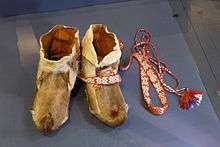Nutukas
Nutukas, finnesko, or simply Sámi boots are traditional Sámi winter footwear made of reindeer hide. Because they are soft, the nutukas will not freeze as solidly as thick boot leather, making them relatively easy to put on after overnight exposure to subzero temperatures.[1] From 1890, they are regularly mentioned in accounts of polar travel.[2][3]

Construction
Nutukas are made from soft hide, traditionally from a reindeer's leg or head, with the fur left on and sewn so that the fur is on the outside of the boot.[4] On the sole the pieces are assembled with cut in the middle so that the fur goes in different directions to improve traction in snow. [5] The shaft of the boot is laced with a wide strap, often highly decorative, that are wound it several rows to keep snow out of the boot. Traditionally, a grass, (such as sennegrass),[6] was used inside the boot to keep the foot dry and warm; now, a felt slipper or valenki is commonly worn instead.
The stiff beaked toe of Sámi boots differentiate nutukas from mukluks and other styles of Arctic footwear.[7] Although the shape of the curved up beak varies regionally, it serves the same purpose of helping to hold firm a traditional binding strap on a pair of skis.[8] The toe helps to keep the boot from sliding back and out of the binding as the ski kicks back.[9]
Terminology
In Northern Sámi, such boots are called nuvttat or gállohat. In Lule Sámi they are nuvtaga, and in Southern Sámi they are gejhkehke. The word nutukas comes from Finnish. Finnesko is an antiquated word coming from Norwegian. In contemporary Norwegian (both Bokmål and Nynorsk), nutukas are referred to as skallar. In Swedish, the boots are referred to as bällingsko or "bell shoes," while in Russian they are called пимы (pima).
Variations
The style and form of nutukas varies depending on the cultural area and the wearer. Similar footwear is used by other indigenous peoples of the European Arctic, including the Komi, Nenets, Khanty, and Mansi.
References
- Hince, Bernadette (2000). The Antarctic Dictionary: A Complete Guide to Antarctic English. CSIRO Publishing. ISBN 0 9577471 1X.
- Shackleton, Ernest (1998). South: A Memoir of the Endurance Voyage. Robinson. ISBN 1841190349.
- Scott, Captain Robert F. (1905). The Voyage of the 'Discovery'. London: Macmillan and Co. p. 244.
- "Traditional Sami Reindeer Fur Boots: Skaller". ThorNews.com. August 25, 2013. Archived from the original on 13 November 2016. Retrieved 13 November 2016.CS1 maint: BOT: original-url status unknown (link)
- All About Shoes: Footwear Through the Ages. Zlín, Czechia: Bata Limited. 1 January 1994. p. 15. ISBN 978-0-9692076-1-0. Retrieved 28 April 2020.
- "Bruk av land og vann i Finnmark i historisk perspektiv" [The use of land and water in Finnmark in historical perspective]. Norges Offentlige Utredninger (in Norwegian). Norwegian Ministry of Justice and Public Security. 1994 (21). 1994. Retrieved 29 April 2020.
- Sumberg, Bobbie (2010). Textiles: Collection of the Museum of International Folk Art. Santa Fe, New Mexico: International Museum of Folk Art. p. 159. ISBN 978-1-4236-0650-5. Retrieved 29 April 2020.
- Oakes, Jill (28 April 2020). "Inuit and Arctic Footwear". Encyclopedia of Clothing and Fashion. encyclopedia.com. Retrieved 29 April 2020.
- Masia, Seth. "History of Ski Boots". Manchester Center, Vermont: International Skiing History Association. Retrieved 29 April 2020.
![]()